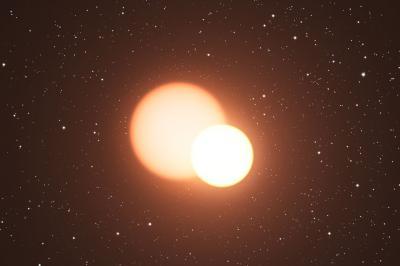This remarkably precise relationship makes the study of Cepheids one of the most effective ways to measure the distances to nearby galaxies and from there to map out the scale of the whole Universe.
Despite the extensive nature of their studies, Cepheids are not fully understood. Predictions of their masses derived from the theory of pulsating stars are 20% less than predictions from the theory of the evolution of stars. This odd discrepancy has been known since the 1960s.
To resolve this conflict between the two competing theories, astronomers needed to find a double star containing a Cepheid where the orbit happened to be seen edge-on from Earth. In these eclipsing binaries, the brightness of the two stars dims as one component passes in front of the other, and again when it passes behind the other star. In such pairs astronomers can determine the masses of the stars to high accuracy - but neither Cepheids nor eclipsing binaries are common, and the chances of finding such an unusual pair seemed very low. No such pair is known in the Milky Way.
But it has happened. Wolfgang Gieren, a member of the team led by Grzegorz Pietrzyński (Universidad de Concepción, Chile, Obserwatorium Astronomiczne Uniwersytetu Warszawskiego, Poland) says, "Very recently we actually found the double star system we had hoped for among the stars of the Large Magellanic Cloud. It contains a Cepheid variable star pulsating every 3.8 days. The other star is slightly bigger and cooler, and the two stars orbit each other in 310 days. The true binary nature of the object was immediately confirmed when we observed it with the HARPS spectrograph on La Silla."

Artistic impression shows the double star OGLE-LMC-CEP0227 in our neighboring galaxy the Large Magellanic Cloud. The smaller of the two stars is a pulsating Cepheid variable and the orientation of the system is such that the stars eclipse each other during their orbits. Studies of this very rare system have allowed astronomers to measure the Cepheid mass with unprecedented accuracy. (Photo Credit: ESO/L. Calçada
The observers carefully measured the brightness variations of this rare object, known as OGLE-LMC-CEP0227, as the two stars orbited and passed in front of one another. They also used HARPS and other spectrographs to measure the motions of the stars towards and away from the Earth — both the orbital motion of both stars and the in-and-out motion of the surface of the Cepheid as it swelled and contracted.
This very complete and detailed data allowed the observers to determine the orbital motion, sizes and masses of the two stars with very high accuracy — far surpassing what had been done before for a Cepheid. The mass of the Cepheid is now known to about 1% and agrees exactly with predictions from the theory of stellar pulsation. However, the larger mass predicted by stellar evolution theory was shown to be significantly in error.
The much-improved mass estimate is only one outcome of this work, and the team hopes to find other examples of these remarkably useful pairs of stars to exploit the method further. They also believe that from such binary systems they will eventually be able to pin down the distance to the Large Magellanic Cloud to 1%, which would mean an extremely important improvement of the cosmic distance scale.
Pietrzyński says, "By using the HARPS instrument on the 3.6-metre telescope at ESO's La Silla Observatory in Chile, along with other telescopes, we have measured the mass of a Cepheid with an accuracy far greater than any earlier estimates. This new result allows us to immediately see which of the two competing theories predicting the masses of Cepheids is correct."
Citation: G. Pietrzyński, I. B. Thompson, W. Gieren, D. Graczyk, G. Bono, A. Udalski, I. Soszyński, D. Minniti, B. Pilecki, 'The dynamical mass of a classical Cepheid variable star in an eclipsing binary system', Nature 468, 542-544 (24 November 2010) doi:10.1038/nature09598




Comments